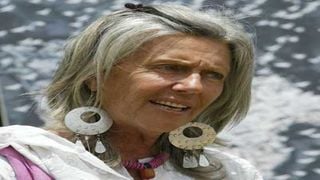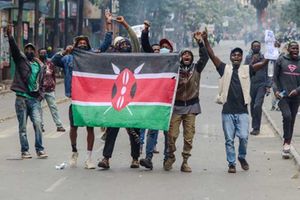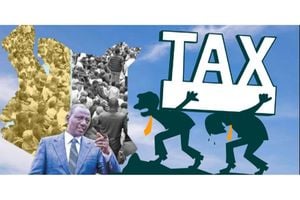
Conservationist Kuki Gallmann whose education centre was torched by armed bandits on August 20, 2021.
| File | AFPNews
Premium
A tale of love, death and the battle for Kuki Gallmann’s 100,000-acre ranch in Laikipia
On April 12, 1980 celebrated writer and conservationist Kuki Gallmann placed a tiny acknowledgement in the classified section of this paper following the death of her tycoon husband, Paolo Gallmann.
A short-lived love story that started from a hospital bed in Venice, Italy, had ended up in Laikipia, where the couple had bought the now troubled Laikipia Nature Conservancy —where police are trying to keep armed bandits and “illegal herders” at bay.
Ol Ari Nyiro, as this ranch is known, was an escape from heartache — and it appears that it might end in tears.
The story starts in the late 1960s in Italy, on the banks of River Sile. A new fish restaurant had opened and one evening the 20-something-year-old Kuki, divorced, decided to join her childhood neighbours Carletto Ancilotto and his wife Chiara for dinner — and later dance. They had also picked another couple Paolo Gallmann and his wife, Mariangela.
Kuki looked at Paolo. “It was impossible to ignore Paolo. He radiated energy; his aura of intense liveliness and awareness was extremely attractive,” Kuki would later say in her book, I Dreamed of Africa.
At only 19, Kuki had dropped out of university and got married to Mario, half-Sicilian and half-Piedmontese. “My father … was strongly opposed to our marriage as he felt it could not last,” she recalled.
Test of time
Her father was right: “Our marriage lasted just over two years. My lack of experience and my love for Mario could not disguise my intuition that our relationship could not stand the test of time, and I felt that the pain of an early separation was better than the unavoidable bitterness which wasted years of youth would bring.”
That evening, a Naivasha-based farmer and actor Dorian Rocco, whose family had built the Sirocco House on the shores of Lake Naivasha, had arrived and borrowed Paolo’s car.
“The food was excellent and our spirits were high. Afterwards we split up and changed vehicles, since Carletto and Chiara had decided to go home and all the rest of us wanted to go dancing.”
And that is when the car accident happened. Paolo’s wife, Mariangela, died. Paolo suffered from fractured jaw and ribs. Kuki had multiple fractures, and for eight months she just lay in her hospital bed — with Paolo making countless trips to see her. As she later wrote, “his presence lit the hospital room with golden light.”

Laikipia Nature Conservancy director Ms Kuki Gallmann stands next to a carcass of a lioness killed by Game rangers attached to the Conservancy.
Paolo’s tales of Kenya’s wilderness — the virgin territory that was teeming with wildlife, “the wild open horizons and red sunsets” — thrilled Kuki.
She dreamt of Africa; a faraway place where both could escape. “You must get better. You must walk again. Then I will show you Kenya,” Paolo told her.
It was February 1970 when she was flown to Kenya while still on a wheelchair and it took her three years to walk again.
It was Kuki who suggested to her new husband that they move from Venice to Kenya where he desired to carry our cattle ranching. He had a Phd in agriculture. So in 1972, Kuki, Paolo and her young son Emanuele moved to Kenya.
In Nairobi, they bought a house in Gigiri and a four-wheel-drive car to help them scout for the farm they wanted. In one of their escapades — and they had many — they decided to tour Laikipia where an Italian widow, Antonietta Buonajuti was still running her Colobus Ranch, which she later sold to Laikipia West Land Buying Company which was fronted by G G Kariuki, then an assistant minister in the Jomo Kenyatta government.
Colobus Ranch bordered Ol Ari Nyiro, a ranch that was owned by absentee landlords and managed by Colin Francombe, whose father flew Queen Elizabeth from Nairobi after her father’s death.
White settler
On the eastern side was Gilbert Colvile’s Ol Morani Ranch — which was later sold to Laikipia West Land Buying Company and was the scene of recent skirmishes. He also owned Lariak, which covered 160,000 acres.
Actually, before Kuki Gallmann settled here, Gilbert was the best known white settler in Laikipia. He also had 30,000 acres in Ndabibi, Naivasha, and who was described in the book White Mischief as “a small, awkward, chinless man, … a miser and a hermit, who lived in comparative squalor with his many dogs, and whose house had the sour, wood-smoke smell of the Masai boma.”

Police officers patrol the Laikipia Nature Conservancy in Laikipia West on March 30, 2017 where a luxurius lodge was burnt down by illegal herders
Something else about this neighbour was that he loved Maasai snuff, spoke the language, and had more Maasai cattle than anyone else in Kenya.
After Lord Eroll was shot, Colvile bought his house near Lake Naivasha and gave it to Diana Delves-Broughton and later married her. Diana would later divorce Colvile to marry Lord Delamere but when Colvile died he left all his ranches to Diana.
These were the ranchers of Laikipia and who had taken over the land cleared of the Maasai and other pastoral tribes as part of the White Highlands.
After various visits as Francombe’s guests in Laikipia, the Gallmanns fell in love with the 400 square kilometre ranch.
It was a luxuriant place with “untouched cedar forest of Enghelesha”, the “steep dramatic cliffs of the breathtaking Mukutan Gorge” and “blue hills and groves of acacia; open savannah dotted with trees; unending views of craters and volcanoes made purple and pink by the heat and the distance ... with Lake Baringo shimmering with all its islands 3,000 feet below.”
They bought the ranch and stocked it with thousands of Dorper sheep and Boran cattle — and built a permanent house. It was also where they hunted wildlife for fun.
They bought a plane and built an airstrip.
In March 19, 1980, Paolo was driving to Mombasa to buy a baby crib carved out of a mango tree in the shape of canoe. “At the time, I was not even pregnant,” wrote Kuki. And then it happened. “A lorry … suddenly crossed into his lane at the petrol station in front of Hunter’s Lodge … Paolo was dead.”
Three years later, her son Emanuele, 17, was bitten by a puff adder whose venom he was trying to extract.
After Paolo’s death, Kuki, as she is fondly known, was left to manage one of the largest ranches in Kenya — the 98,000-acre Ol Ari Nyiro. It was a dangerous territory.
Without her, this would be poacher’s paradise. It was also a territory regarded by the Pokots as their ancestral land. On page 143 of her book, she says: “The Pokot…knew Ol Ari Nyiro from time immemorial, as it had once been their territory where they had run cattle and goats.”
Ol Ari Nyiro means the place of springs and that tells you how important it is to both pastoralists and ranchers — especially during the dry season.
In the late 70s, Kuki had noticed poaching had taken a new dimension here: “Gangs of Somali infiltrated the Pokot, and provided a market for ivory and rhino horn. The price they offered for a horn represented over a year’s income and was a temptation the Pokot people could not resist.”
There was also pressure, over the years, to sell this place or leave.
Wildlife heritage
But Kuki decided to stay and for a reason. “Going away would mean renouncing this responsibility and declaring defeat.” She wrote in her book. “I had found Ol Ari Nyiro teeming with wildlife. I wanted to protect it, even if theoretically this was not my task and nobody expected me to do it. I wanted to protect it because of Paolo, because of Emanuele and because of my own self-respect.”
The destruction of Colvile ranch and its wildlife heritage troubled her. “All around us I could see what would happen if I let go. Across the hill of Enghelesha, Colobus Farm was being chopped into small shambas where wildlife had no place.”
This was in reference to Laikipia West Farmers land — where G G Kariuki settled thousands of people when he was in the Ministry of Lands and Settlement. The land borders Ol Ari Nyiro.
“The idea of selling that beauty for money not only appeared to me ugly and pointlessly greedy. It would be an act of cowardice … That landscape had been there long before our advent. It would still be there after I left. Not only had I no right to spoil it, but I had to be actively involved in protecting it … this was my inheritance.”
In April 2017, Kuki Gallmann came face-to-face with her haters. They fired into her car and two bullets pierced her abdomen. She survived.
This was followed by a raid on the ranch, now turned into a conservancy, where tens of elephants were butchered and some of the properties were vandalised.
The last such skirmishes happened during the electioneering period and Kuki had told a British publication that these were not bandits.
This year, Kuki’s Laikipia Nature Conservancy became the theatre of recent skirmishes in Laikipia as armed gangs invaded the land where she buried her son and husband.
Already, the land has been declared a troubled zone and a curfew imposed at the 100,000 acre farm – one of the biggest single block ranches in the country.
Local politicians have been pushing for a government takeover of the conservancy and it appears that the salivating for Kuki’s conservancy will not end soon.
Today, her dream of Africa is turning into a nightmare. She wants this piece of Africa preserved. In here, she has become a celebrated writer and her book, I Dreamed of Africa was turned into a Hollywood movie and the book has sold millions of copies.
But who wants Kuki out of Laikipia?
[email protected] @johnkamau1




